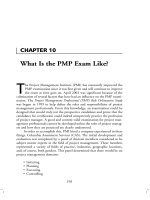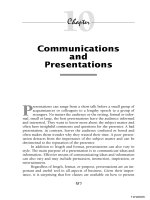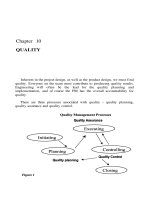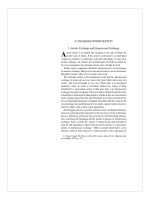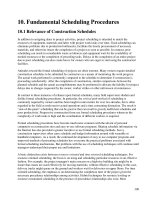Crisis intervention strategies chapter 10
Bạn đang xem bản rút gọn của tài liệu. Xem và tải ngay bản đầy đủ của tài liệu tại đây (8.39 MB, 19 trang )
Chapter Ten:
Partner Violence
Background
• Culture has a role in the definition of partner
violence
• Not limited to a husband and wife relationship
• Common terms:
•
•
•
•
Battering-physical violence perpetrated by one person on another
Abuse-general term that describes the unequal power relationship
within which the assault occurs
Assault-verbal and behavioral threats to others, pets, or property
Domestic violence-any act of assault by a social partner or relative,
regardless of marital status
Incidence of Partner Violence
• Bradley v. State of Mississippi, 1824
• State of North Carolina v. Oliver, 1874
• Domestic disturbance calls outnumber other types
of calls in which the possibility of violence exists to
both civilians and police
Incidence of Partner Violence Cont.
• 1.5 million women and 830,000 men were victims of
intimate violence in the United States
• 15.5 million children live in families where violence
has occurred and about 7 million have witnessed
severe violence
•
These rates are apparently decreasing
Emerging Approaches to
Partner Violence
• Scream Quietly or the Neighbors Will Hear, 1974
(England)
• National Organization for Women and Massachusetts
Coalition of Battered Women Service Groups (United
States)
• The Domestic Abuse Intervention Project in Duluth,
Minnesota (Duluth Model)
•
•
•
Police procedures, increased prosecution of partner violence, and
enhanced legal protection
Countywide coordinated community responses
Domestic violence units have been formed
• The Violence Against Women Act of 1994
Psychosocial and Cultural Dynamics
•
•
•
•
•
•
•
•
•
•
•
•
•
Attachment/Traumatic Bonding Theory
Coercive control
Cultural reinforcement
Exchange Theory
Feminist Theory
Intraindividual Theory
Learned Helplessness/Battered Woman Syndrome
Masochism
Nested Ecological Theory
Psychological entrapment
Sociobiology
Stockholm Syndrome
System Theory
Dynamics of Partner Violence
• Psychological factors
•
Behaviors of men vs. women
• Stressors
•
•
•
•
•
•
•
•
•
•
•
•
Geographic and social isolation
Economic stress
Medical problems
Inadequate parenting skills
Pregnancy
Family dysfunction
Substance abuse
Education/vocational disparity
Age
Disenfranchisement
Rejection
Threat to masculinity
Dynamics of Partner Violence Cont.
• Types of batterers
•
•
•
•
Family only
Dysphoric/borderline
Violent/anti-social
Low-level anti-social
• The cycle of violence
•
•
•
•
Phase I: Tranquility prevails
Phase II: Tensions starts to build
Phase III: A violent episode occurs
Phase IV: The relationship takes on crisis proportions
• Abuser is remorseful and the victim forgives them
• Abuser is not remorseful and asserts control over the victim
• The victim takes new action
Myths About Battering
Battered women overstate the case
Battered women provoke the beating
Battered women are masochists
Battering is a private, family matter
Alcohol abuse is the prime reason for spousal
abuse
• Battering occurs only in problem families
• Only low-income and working-class families
experience violence
•
•
•
•
•
Myths About Battering Cont.
• The battering cannot be that bad or the victim would
•
•
•
•
•
•
•
leave
A husband has patriarchal rights
The beaten spouse exaggerates the problem to exact
revenge
Women are too sensitive, especially when they are
pregnant
Battering is rare
Battering is confined to mentally ill people
Violence and love cannot coexist
Elder abuse between partners is neither prevalent nor
dangerous
Realities for Abused Women
• Victim has a fear of reprisal.
• She is grateful that her children have food, clothing, and
•
•
•
•
•
•
shelter.
She believes that she will suffer shame if her secret gets out.
Her self-concept is dependent on the relationship.
Early affection and prior love in the relationship persist.
If financially well off, the woman is unable to deal with a
reduction in her financial freedom.
In the cyclic nature of abuse, she may tend to forget the
batterings and remember only the good times.
Early role models of an abusive parent may lead her to believe
that relationships exist in no other way.
Realities for Abused Women Cont.
• The woman may hold religious values that strongly discourage
•
•
•
•
•
•
separation or divorce.
The woman may be undereducated, have small children to raise,
or lack job skills.
She may be so socially, physically, geographically, or financially
isolated that she has no resources.
She may be so badly injured that she is unable physically to leave.
Love or sorrow at the mate’s professed inability to exist without
her may compel her to stay.
Because of previous negative experiences with the authorities, she
may believe she has no options.
Due to language barriers, she may be unable to communicate her
abuse.
Leaving an abusive relationship is one of the most dangerous things
the victim can do.
Intervention Strategies
• Assessment
•
•
•
•
Personality measures
Clinical interviews
Medical settings
Crisis lines
• Components of intervention
•
•
•
•
•
•
Listening
Supporting
Facilitating
Ensuring safety
Advocating
Transcrisis perspective
Shelters
• Counseling women at shelters
•
•
•
•
•
Shelter dynamics
Grief
Depression
Terror
Those who have decided to leave
• Follow-up
•
•
•
•
Counseling
Victim may relapse and re-unite with the abuser
Long-term follow support (6 months)
Going to a shelter without follow-up may increase violence
Intervention With Children
• Art and play models of therapy
• Treatment goals:
•
•
•
•
•
•
•
•
•
Create an alliance with the parent
Provide psycho-education to both parent and child
Restore the parent’s self-esteem and confidence
Establish a safe environment for the child to express thoughts and
feelings
Relieve the child’s symptoms, including difficulty with living
transitions, sleeping, nightmares, and other trauma symptoms
Reestablish the child’s previous level of cognitive functioning and
attachment with the caregiver
Reassure that what has happened is not the child’s fault
Help the child to regain emotional regulation
Provide stress reduction strategies
Courtship Violence
• Violence occurs in approximately 25% of courtship
•
•
•
•
•
relationships
Number of dating partners and dating frequency have
the highest positive correlation
Grade point average has the highest negative
correlation
25% of victims and 30 percent of offenders interviewed
interpreted violence in courtship as a sign of love!
The longer the abusive relationship continues, the
higher the degree of violence
Stalking
Gay and Lesbian Violence
• Prevalence of violence
• Complicating factors
• Crisis intervention involving gay and lesbian
violence
•
•
•
•
•
•
Sensitivity
Precipitating factors
Specific issues
Severity
Safety and support
Treatment issues
Treating Batterers
•
•
•
•
•
•
•
Intervention models
Treatment models
Hybrid models
Treatment goals
Assessment
The intake interview
Motivation
A Typical 24-Session Anger Management
Group
•
•
•
•
•
•
•
•
•
•
•
•
•
•
Starting the Group
Making Choices
Support and Confrontation
Managing Stress
Understanding the Cycle of Violence
Costs
Intergenerational Issues
Feelings
Power and Control
Assertion
Alcohol and Drug Effects
Sex
Summing Up
Programs Success



